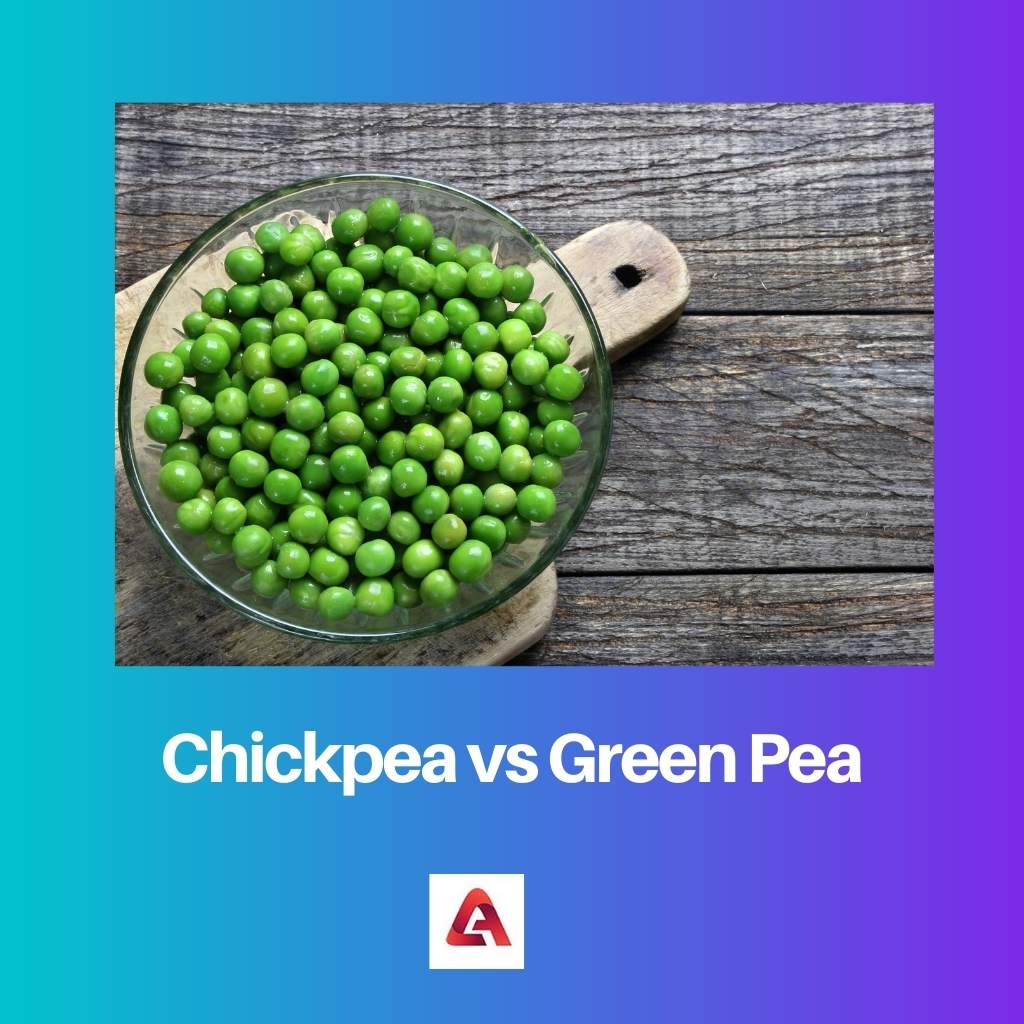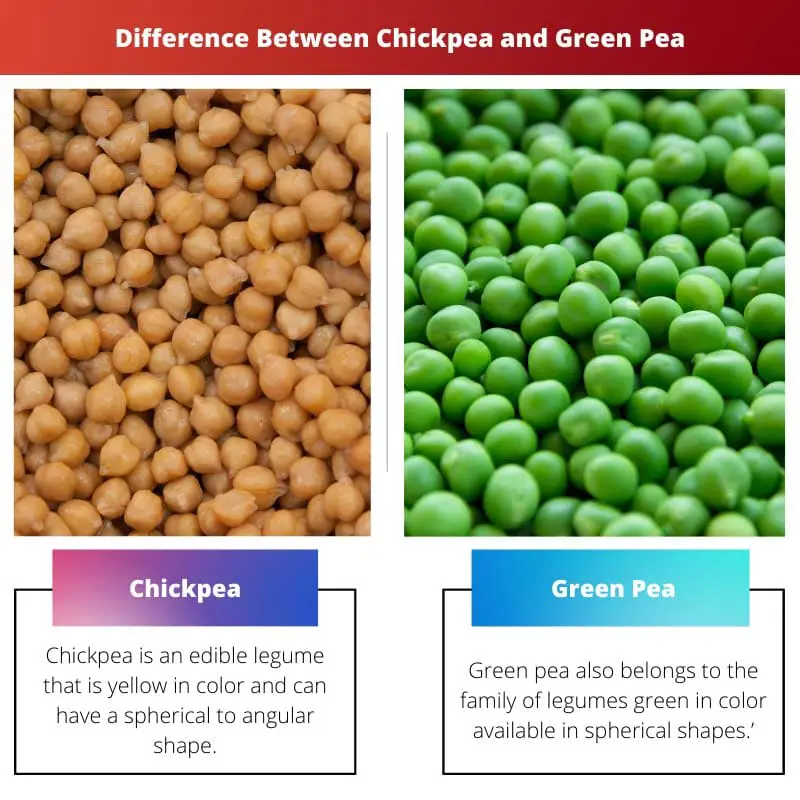Our body needs proteins, carbohydrates, etc., on a daily basis for building up muscles and other body cells. For that purpose, doctors recommend we eat green vegetables, legumes, lentils, etc. Different types of vegetables provide us with different types of nutrients some are rich in proteins, and some are carbohydrates etc.
Chickpeas and green peas are types of legumes consumed by humans for building up proteins and carbohydrates, etc. Legumes are dry grains like peanuts, peas, etc. that help us to gain proteins and nutrients. We can also eat them without cooking or raw.
Key Takeaways
- Chickpeas and green peas are different legumes with distinct nutritional profiles and culinary uses.
- Chickpeas are a good protein, fiber, and iron source and are used in Mediterranean and Middle Eastern cuisine for dishes such as hummus and falafel. Green peas are a good source of vitamin C, K, and manganese and are used in soups, salads, and stir-fries.
- While both legumes offer health benefits, they have different tastes, textures, and cooking methods and are not interchangeable in recipes.
Chickpea vs Green Pea
The difference between Chickpea and Green pea is that Chickpea belongs to the legume family, and it is yellow in color having spherical to angular shape. In contrast, the Green pea is mostly green in color and has a spherical shape with a lifecycle of one year, not more than that.

Chickpea is a leguminous seed-like grain spherical or angular in shape and is available in yellow, black colors, etc. They absorb water very easily and become soft. Animals are mostly fed with these types of legumes. It is also known as gram in most Asian countries.
Green peas are very nutritious and are low in saturated fat. They also belong to the legume family, but they have different features. It is a pod fruit which means it comes inside a folded leguminous plant which, when torn apart, contains peas lined together.
Comparison Table
| Parameters of Comparison | Chickpea | Green Pea |
|---|---|---|
| Definition | Chickpea is an edible legume that is yellow in color and can have a spherical to angular shape. | Green pea also belongs to the family of legumes green in color available in spherical shapes.’ |
| Family | Belongs to the Fabaceae family or Leguminosae family. | It also belongs to the Fabaceae family or Leguminosae family. |
| Color | Chickpeas are mostly yellow in color but can also have a black color, pale yellow color, etc. | Green peas are green in color, sometimes light green, but mostly dark green. |
| Nutritional Value | 1. Protein= 21% 2. Carbohydrate= 65% 3. Fat= 14% 4. Linoleic acid= 1.113g | 1. Protein= 26% 2. Carbohydrate= 69% 3. Fat= 5% 4. Linoleic acid= 0.152g |
| Kingdom | It belongs to the kingdom of Plantae. | It also belongs to the kingdom of Plantae. |
| Scientific name | Chickpea can also be called scientifically as Cicer arietinum. | Green pea is scientifically known as Pisum sativum. |
| Taste | Most of the time it has no taste. | It can be slightly sweet or can have a neutral taste. |
What is Chickpea?
Chickpea belongs to a legume family and is also called gram in many Asian countries. Most of the food items are made using Chickpeas. Their nutrient value is slightly less than Green peas. The widely used Asian chana masala has Chickpeas as its main ingredient.
Chickpeas are consumed mostly in Asian countries as most food items in these countries are made using Chickpeas. Scientifically Chickpeas are called Cicer arietinum. They don’t have any strong taste when eaten raw. The fat percentage in them is high as compared to Green peas.
Chickpeas’ origin is said to be in Turkey. The Chickpea plant is 20-40 cm in height, ad it comes in the category of pulses or grains. Mostly it is produced in India and then exported to other countries.

What is Green Pea?
Green pea is a pod fruit and is highly nutritious. Because of its less fat content, it is mostly recommended when someone is dieting. They have a spherical shape and are green in color. The life expectancy of these types of plants is not more than one year.
Green peas can have some taste like a sweet or neutral taste. They are scientifically nomenclature as Pisum sativum. They can be eaten raw or uncooked as they are soft and have a neutral taste. Green peas’ weight can vary from 0.1 to 0.35 grams depending on their size and growth.
Green pea is mostly available in winter because their cultivation season is winter. The pea plant can self-pollinate, and its color may vary from green to light golden color.
| # | Preview | Product | |
|---|---|---|---|
| 1 |

| 365 by Whole Foods Market, Peas Green Organic, 16 Ounce | Check Price on Amazon |
| 2 |

| Amazon Brand - Happy Belly Green Peas, 12 ounce (Pack of 1) (Frozen) | Check Price on Amazon |

Main Differences Between Chickpea and Green Pea
- Chickpea belongs to the legume family, and it is yellow in color having spherical to angular shape. In contrast, the Green pea is mostly green in color and has a spherical shape with a lifecycle of one year, not more than that.
- Green Peas can be slightly sweet or can have a neutral taste depending on their growth. On the other hand, Chickpeas, most of the time, have no taste.
- Chickpea is also known scientifically as Cicer arietinum. In contrast, the scientific name of the Green pea is Pisum sativum.
- Green peas are green in color, sometimes light green but mostly dark green, depending on their growth and environment. While Chickpeas are mostly yellow in color but can also have a black color, pale yellow color, etc.
- Green pea belongs to the legume family and has higher protein and carbohydrate content. Chickpea also belongs to the legume family, but their nutrient content is less than a Green pea.




The detailed nutritional breakdown and scientific classification of chickpeas and green peas make this article a valuable source of information.
I share the same view, Eleanor. This content is certainly enlightening.
The comparison of chickpeas and green peas is very informative and helpful in understanding the distinction between these two types of legumes.
I totally agree, Evelyn. It’s fascinating to learn about the different nutritional values and uses of these legumes.
It’s very important to be aware of the different nutrients that we consume daily. The differences between chickpeas and green peas are very interesting to know as well.
I agree, Chris. Knowing the nutritional differences between different foods is essential for a balanced diet.
Absolutely, the nutritional content of legumes like chickpeas and green peas play a crucial role in our overall health.
The distinction between chickpeas and green peas is well-explained here, shedding light on their unique properties and benefits.
Indeed, Zreid. It’s fascinating to learn about the diverse nutritional compositions of these legumes.
The nutritional profiles and origins of chickpeas and green peas have been elucidated comprehensively, making it easier to discern between the two.
I couldn’t agree more, Noah. The information provided here is incredibly insightful.
This article is a valuable resource for understanding the nutritional and botanical aspects of chickpeas and green peas in detail.
The detailed descriptions of chickpeas and green peas have increased my understanding of the nutritional content and characteristics of these legumes.
Absolutely, Lrogers. The nutritional information presented here is tremendously helpful.
I share the same sentiment, Lrogers. This article has provided valuable insights into these food items.
The information provided on the origins and uses of chickpeas and green peas offers a comprehensive understanding of these legumes’ significance in our diets.
Indeed, Tracy98. This article presents essential knowledge on these food products.
Absolutely, Tracy98. The depth of information provided here is commendable.
The detailed comparison table provides a clear overview of the differences between chickpeas and green peas, especially with regards to their nutritional value and characteristics.
I couldn’t agree more, Walker. Understanding these differences can help individuals make more informed dietary choices.
This article does an excellent job of highlighting the key differences in taste, nutritional value, and uses of chickpeas and green peas.
Absolutely, Beth09. It’s important to be aware of these variations for dietary considerations.
I concur, Beth09. Understanding the nuances of these food items is crucial for informed decision-making.